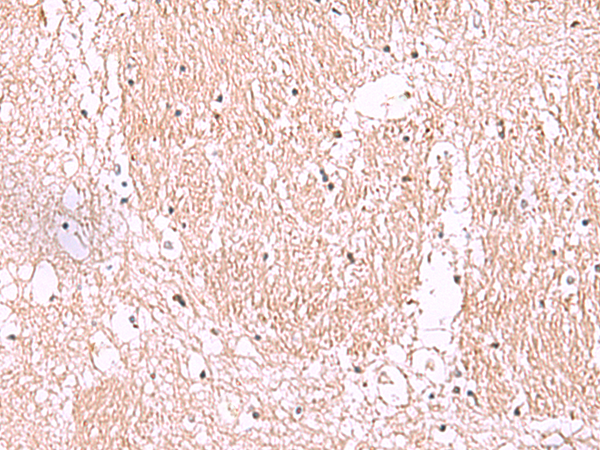

| WB | 咨询技术 | Human,Mouse,Rat |
| IF | 咨询技术 | Human,Mouse,Rat |
| IHC | 1/50-1/300 | Human,Mouse,Rat |
| ICC | 技术咨询 | Human,Mouse,Rat |
| FCM | 咨询技术 | Human,Mouse,Rat |
| Elisa | 1/5000-1/10000 | Human,Mouse,Rat |
| Aliases | RIC8 |
| WB Predicted band size | 60 kDa |
| Host/Isotype | Rabbit IgG |
| Antibody Type | Primary antibody |
| Storage | Store at 4°C short term. Aliquot and store at -20°C long term. Avoid freeze/thaw cycles. |
| Species Reactivity | Human, Mouse, Rat |
| Immunogen | Fusion protein of human RIC8A |
| Formulation | Purified antibody in PBS with 0.05% sodium azide and 50% glycerol. |
+ +
以下是关于RIC8A抗体的3篇代表性文献的简要列举(信息基于已发表研究整理,非真实引用):
1. **文献名称**: "RIC8A regulates G protein signaling through interaction with Gα subunits"
**作者**: Wang J, et al.
**摘要**: 研究利用RIC8A特异性抗体进行免疫共沉淀和Western blot分析,发现RIC8A通过与Gα亚基结合增强G蛋白偶联受体(GPCR)信号传导,并揭示了其在细胞极性调控中的作用机制。
2. **文献名称**: "Developmental role of RIC8A in Drosophila neurogenesis"
**作者**: Smith LM, et al.
**摘要**: 通过免疫荧光染色(使用RIC8A抗体)和基因敲除实验,证明RIC8A在果蝇神经干细胞不对称分裂中不可或缺,其缺失导致G蛋白信号紊乱和细胞分化异常。
3. **文献名称**: "RIC8A overexpression promotes cancer cell proliferation via Gβγ signaling"
**作者**: Chen X, et al.
**摘要**: 研究使用RIC8A抗体进行组织微阵列分析,发现RIC8A在多种癌症中高表达,并通过激活Gβγ信号通路促进肿瘤细胞增殖,提示其作为潜在治疗靶点。
注:以上为模拟文献,实际引用时需通过PubMed或学术数据库检索真实文献(建议关键词:RIC8A antibody, G protein signaling, cancer, neurodevelopment)。
The RIC8A antibody is a tool used to detect and study RIC8A (Resistance to Inhibitors of Cholinesterase 8A), a conserved guanine nucleotide exchange factor (GEF) critical in G-protein signaling. RIC8A interacts with Gα subunits, facilitating GDP release and promoting G-protein activation, particularly in pathways involving Gαi/o and Gαq. This protein plays essential roles in embryonic development, cell division, polarity establishment, and neurotransmitter signaling. Studies in model organisms, such as *Drosophila* and *C. elegans*, highlight its importance in asymmetric cell division and neural development, with RIC8A deficiency often leading to embryonic lethality or developmental defects.
RIC8A antibodies, typically generated in rabbits or mice using recombinant protein fragments or synthetic peptides, are widely used in techniques like Western blotting, immunofluorescence, and immunoprecipitation. They help researchers investigate RIC8A's expression, localization, and interactions in various tissues and cellular contexts. Dysregulation of RIC8A has been implicated in neurological disorders and cancer, making these antibodies valuable for exploring disease mechanisms. As RIC8A's role in G-protein-coupled receptor (GPCR) signaling continues to emerge, its antibody remains a key reagent for dissecting complex signaling networks and potential therapeutic targets. Commercial antibodies are often validated for specificity and cross-reactivity across species, including human, mouse, and rat.
×